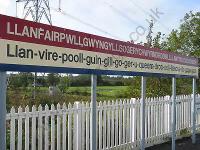Longest village name
 From Wikipedia, the free encyclopedia.
From Wikipedia, the free encyclopedia.Llanfairpwllgwyngyllgogerychwyrndrobwllllantysiliogogogoch is a
village on the island of Anglesey in Wales. Situated on the Menai
Strait close to Menai Bridge and Bangor, it is best known for having
the longest officially recognised place name in the United Kingdom,
and one of the longest in the world. It is signposted on surrounding
roads as Llanfairpwllgwyngyll, and generally known as Llanfairpwll or
Llanfair locally. The name is also seen shortened to Llanfair PG,
which is sufficient to distinguish it from the many other Welsh
villages with Llanfair in their names.
It is a popular tourist destination, with many people stopping at the
railway station to be photographed next to the station sign, visiting
the nearby visitors' centre, or having 'passports' stamped at a local
shop. Another tourist attraction is the nearby Marquess of Anglesey's
Column, which at a height of 27 m offers views over Anglesey and the
Menai Strait. Designed by Thomas Harrison, the monument celebrates the
heroism of Henry Paget, 1st Marquess of Anglesey at the Battle of
Waterloo. In recent times the village has grown and is now somewhat
like a northern suburb of Bangor, on the other side of the Menai
Strait.
Name
A sign showing the name is visible in the background.The village's
long name was contrived in the 1860s for the prestige of having the
longest name of a railway station in Great Britain, and could not be
considered an authentic word in the Welsh language. A translation into
English would yield "St Mary's church in the hollow of the white hazel
near a rapid whirlpool and the church of St Tysilio near the red
cave".
The village was originally known as Llanfairpwllgwyngyll, and there
was a nearby hamlet called Llantysilio Gogogoch. The names were linked
by an in-between feature, the chwyrn drobwll, or rapid whirlpool.
There have been several attempts to steal the village's record. The
Carmarthenshire village of Llanfynydd unofficially adopted the name
Llanhyfryddawelllehynafolybarcudprindanfygythiadtrienusyrhafnauole in
2004 in protest at plans to erect a wind farm nearby (the name means
"a quiet beautiful village, an historic place with rare kite under
threat from wretched blades" in English). A station on the Fairbourne
Railway was named
Gorsafawddacha'idraigodanheddogleddollônpenrhynareurdraethceredigion
(translated as "the Mawddach station and its dragon teeth at the
Northern Penrhyn Road on the golden beach of Cardigan Bay") for
promotional purposes. No such attempts have gained widespread
recognition amongst official bodies and transport authorities.
Receive post updates by Email



























 Add my feed to your Rss
Add my feed to your Rss
